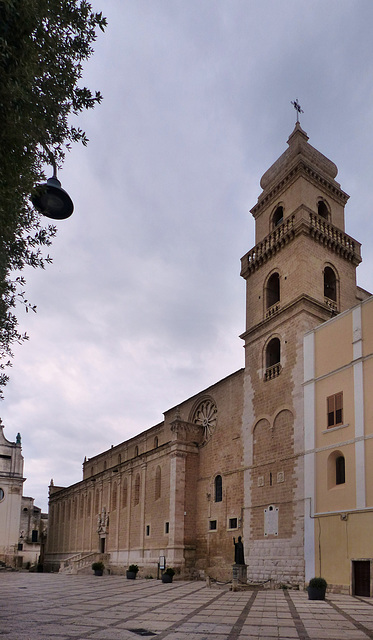Gravina in Puglia - Concattedrale di Santa Maria A…
Gravina in Puglia - Ponte Acquedotto Viadotto dell…
Parco Nazionale dell'Alta Murgia
Cantoniera No. 2
Trani - San Giacomo
Trani - San Giacomo
Trani - San Giacomo
Trani - San Giacomo
Trani - San Martino
Trani - San Martino
Trani - Castello svevo
Trani - Alimentari
Trani - Monastero di Santa Maria di Colonna
Trani - Monastero di Santa Maria di Colonna
Bisceglie - ECOBOLLE
Bitonto - Concattedrale di Bitonto
Bitonto
Napoli - Santo Diego
Napoli - Porta Nolana
Napoli - Santa Maria del Carmine Maggiore
Napoli - Santa Croce e Purgatorio al Mercato
Napoli
Napoli
Gravina in Puglia - Concattedrale di Santa Maria A…
Gravina in Puglia - Concattedrale di Santa Maria A…
Gravina in Puglia
Altamura - Cattedrale di Santa Maria Assunta
Altamura - Cattedrale di Santa Maria Assunta
Altamura - Cattedrale di Santa Maria Assunta
Altamura - Cattedrale di Santa Maria Assunta
Altamura - Cattedrale di Santa Maria Assunta
Altamura - Cattedrale di Santa Maria Assunta
Altamura - Cattedrale di Santa Maria Assunta
Altamura - Cattedrale di Santa Maria Assunta
Altamura - Cattedrale di Santa Maria Assunta
Altamura - Cattedrale di Santa Maria Assunta
Altamura - Cattedrale di Santa Maria Assunta
Altamura - Cattedrale di Santa Maria Assunta
Altamura - Cattedrale di Santa Maria Assunta
Altamura - Cattedrale di Santa Maria Assunta
Altamura - Cattedrale di Santa Maria Assunta
Altamura - Cattedrale di Santa Maria Assunta
Altamura - Cattedrale di Santa Maria Assunta
Altamura - Cattedrale di Santa Maria Assunta
Matera - Convento di Sant'Agostino
Location
See also...
Keywords
Authorizations, license
-
Visible by: Everyone -
All rights reserved
-
69 visits
Gravina in Puglia - Concattedrale di Santa Maria Assunta


Gravina was populated already in Stone Age times, it was colonized by the Greeks during the colonization of Greater Greece. The Romans took over around 300 BC and the Via Appia, which linked Rome to Brindisi, passed through Gravina. After the fall of the Western Roman Empire, it was ruled by Goths, Byzantines, Lombards and Saracens. The Normans arrived around 1000. The town was the site of a Norman countship in the Hauteville Kingdom of Sicily and in 1091 the construction of the Norman cathedral started.
Emperor Frederick II had a castle built nearby, that is meanwhile in ruins. From 1386 to 1816 (!) it was a fief of the Orsini family. Feudal oppression led to numerous riots, in particular from 1789 until the unification of Italy in 1861.
A cathedral was built here at the end of the 11th century by Umfrido d'Altavilla (aka Humphrey of Hauteville), Count of Apulia and Calabria.
This "Norman" church was destroyed in 1447-1456 by a fire followed by an earthquake. The present cathedral was rebuilt in the following thirty years following, in a Renaissance-Romanesque style. In the 17th and 18th century the church underwent some Baroque alterations inside. Today the church is presented as a synthesis of different architectural styles: the late Romanesque, the Renaissance and the Baroque.
Emperor Frederick II had a castle built nearby, that is meanwhile in ruins. From 1386 to 1816 (!) it was a fief of the Orsini family. Feudal oppression led to numerous riots, in particular from 1789 until the unification of Italy in 1861.
A cathedral was built here at the end of the 11th century by Umfrido d'Altavilla (aka Humphrey of Hauteville), Count of Apulia and Calabria.
This "Norman" church was destroyed in 1447-1456 by a fire followed by an earthquake. The present cathedral was rebuilt in the following thirty years following, in a Renaissance-Romanesque style. In the 17th and 18th century the church underwent some Baroque alterations inside. Today the church is presented as a synthesis of different architectural styles: the late Romanesque, the Renaissance and the Baroque.
- Keyboard shortcuts:
Jump to top
RSS feed- Latest comments - Subscribe to the comment feeds of this photo
- ipernity © 2007-2024
- Help & Contact
|
Club news
|
About ipernity
|
History |
ipernity Club & Prices |
Guide of good conduct
Donate | Group guidelines | Privacy policy | Terms of use | Statutes | In memoria -
Facebook
Twitter

Sign-in to write a comment.